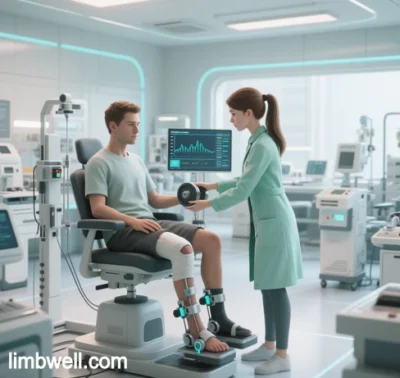
Limb Well: Innovations in Limb Health, Rehabilitation, and Functional Enhancement
The field of limb health is undergoing a paradigm shift, driven by the integration of neuroscience, materials science, and artificial intelligence. This article explores six cutting-edge technological directions, including prosthetic advancements, neural rehabilitation, and human-machine collaboration, highlighting their scientific foundations and clinical impact.
I. Smart Prosthetics: From Mechanical Replacement to Biohybrid Integration
- Neurally Controlled Bionic Prosthetics:
Systems like Linx integrate robotic control of knees and feet, using sensor networks to monitor terrain and movement intent. Adaptive gait adjustment algorithms enable seamless navigation in complex environments. - Biohybrid Prosthetics:
MIT’s “Biohybrid” prosthetics combine regenerative tissue, titanium structures, and neural interfaces, enabling direct neural signal control via microchips like BION, overcoming traditional prosthetic limitations. - Multimodal Sensory Prosthetics:
Tactile feedback systems (e.g., SEM Glove™) convert environmental contact data into electrical signals, restoring sensory-motor loops. Biomimetic microelectrode arrays differentiate textures (e.g., sandpaper vs. silk) for natural interaction.
II. Robotic Rehabilitation: From Passive Training to Active Remodeling
- Exoskeletons:
Cyberdyne’s HAL-ML exoskeleton detects motion intent via surface EMG, providing real-time assistance to improve gait symmetry in stroke and spinal injury patients. Lower-body exoskeletons mimic natural movement to enhance joint mobility and muscle recovery. - Flexible Rehabilitation Robots:
Devices like Hand Mentor Pro use EMG/EEG signals to dynamically adjust resistance during hand training, improving grip precision in stroke patients. Upper-limb robots integrate mirror therapy and adaptive algorithms to address complex regional pain syndrome.
III. Neural Interfaces and Brain-Machine Fusion: From Signal Decoding to Functional Restoration
- Closed-Loop Functional Electrical Stimulation (FES):
MIT’s FES systems guide patient movement via impedance control while stimulating muscle activation, enhancing joint strength. Neural redirection techniques reroute residual nerve signals to control multi-axis prosthetics. - Brain-Computer Interfaces (BCI):
HaptX gloves with BCI create “intent-action-feedback” loops, accelerating upper-limb recovery in stroke patients. Chronic pain management leverages 40Hz vibrations to suppress spinal pain signaling.
IV. Virtual and Augmented Reality: From Simulation to Neural Rewiring
- Immersive Rehabilitation:
VR mirror therapy stimulates the parietal cortex through texture recognition tasks, combined with ultrasound to clear amyloid plaques in Alzheimer’s. AR systems like Hoermann overlay virtual trajectories to improve motor coordination. - Cognitive-Motor Training:
Exergames blend motion sensors with cognitive challenges, reducing gait freezing in Parkinson’s patients. Multisensory feedback (vibration, visuals, sound) activates mirror neurons to enhance motor recovery.
V. Wearables and Biosensors: From Data Capture to Metabolic Regulation
- Smart Diagnostics:
Devices like Eko Core stethoscopes enable remote detection of cardiac anomalies. Tactile canes with IMU navigation provide centimeter-level environmental awareness for visually impaired users. - Metabolic Monitoring:
Near-infrared sensors track cerebral oxygen metabolism during rehabilitation, while optogenetically engineered astrocytes regulate lactate release to reverse synaptic loss post-trauma.
VI. Biohybrid and Synthetic Technologies: From Tissue Repair to Organ Regeneration
- 3D Bioprinting:
Biomimetic tactile corpuscles restore temperature/pressure perception in burn patients. Vascularized tissue growth on titanium interfaces reduces prosthetic infection risks. - Quantum Sensing:
Diamond-based nanoprobes detect single-neuron strain for ultra-early Parkinson’s diagnosis.
Challenges and Ethical Considerations
- Personalization:
AI-driven haptic profiles adapt to age-related sensory thresholds. Biodegradable hydrogels (e.g., PEDOT:PSS-Chitosan) address signal decay in neural implants. - Equity and Privacy:
Open-source platforms democratize access to advanced exoskeletons. Homomorphic encryption and federated learning protect neural-tactile data privacy.
Future Directions
- Bio-Electronic Fusion: Bidirectional neural-prosthetic interfaces for true symbiosis.
- Multiscale Intervention: Quantum sensors and exoskeletons optimize rehabilitation.
- Cloud-Driven Personalization: Adaptive rehabilitation protocols based on genetic and haptic data.
Data sourced from public references. For collaboration or domain inquiries, contact: chuanchuan810@gmail.com





